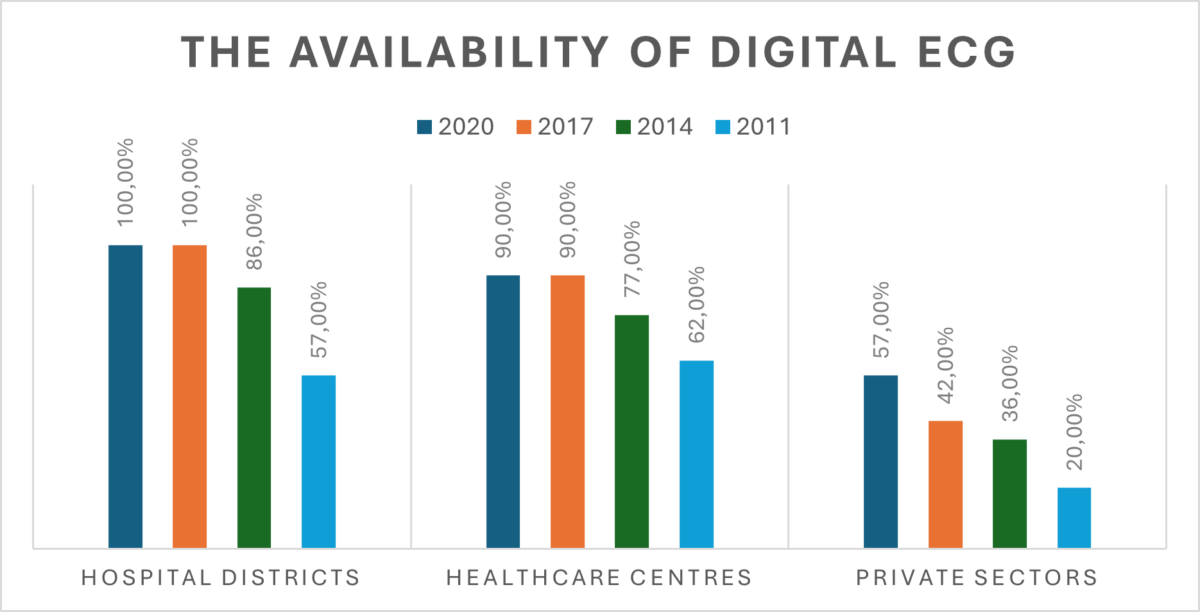
Savonia Article Pro: Digital Transformation at Niuvanniemi Hospital: From paper to digital ECG
Savonia Article Pro is a collection of multidisciplinary Savonia expertise on various topics.
This work is licensed under CC BY-SA 4.0
Introduction
Healthcare has been undergoing a digital evolution over the past decades, and the change is growing stronger. The term “digital health” was first introduced when health records were digitised in the 1990s, but since 2000s, the view of digital health has evolved (Fatehi, Samadbeik & Kazemi 2020). Digital health has been seen to bring more accessibility, increase the quality of care, cut costs and make patient care more individualised. Sharing knowledge and experiences would benefit the evolution of digital health (Ronquillo, Meyers & Korvek 2023).
Digital skills are needed for nurses today since digitalisation is progressing in various stages. Nurses have an important role in healthcare, and they need to have access to and proper training for handling digital tools crafted for healthcare (Finnish Nurses Association 2021).
Transitioning from paper to digital ECG
Electrocardiogram (ECG) has been used for over a century to diagnose cardiovascular activity of the heart and is still a vital part of healthcare (Sattar & Chhabra 2023). Digital evolution has had an impact on ECG as well. Where once ECG signals were printed on paper, they now have been changed to form a digital signal (Baydoun, Safatly, Hassan, Ghaziri, Haij & Isma’eel 2019.) Digital ECG signals can be digitally archived and accessed from various locations; hence evaluation can happen almost instantly. There are instances where ECG signals are still printed on paper (Serhani, Kassabi, Ismail & Navaz 2020). Paper ECGs ink can fade over time, making it harder to interpret (Lim 2023).
Digital implementation has an impact on the performance of work and to its quality. It offers new ways to conduct work in healthcare settings. Digital implementation would make working efficient, speed up the work process, and perhaps eliminate certain processes that have been deemed insufficient (Thun, Bakås & Bjorsvik Storholmen 2021).
According to Reponen, Keränen, Ruotanen, Tuovinen, Haverinen & Kangas (2022) hospital districts are the primary users of digital ECG, whereas private sector is not so keen to adopt it (Figure 1).

Figure 1. Digital ECG in use (adapted from Reponen, Keränen, Ruotanen, Tuovinen, Haverinen & Kangas 2022)
Case Niuvanniemi hospital
The purpose of this study was to research the possibility of implementing a paperless ECG system in the Niuvanniemi hospital NEMO unit. In this way, ECGs would be handled and stored digitally and would be accessible from various locations throughout the hospital for doctors to evaluate the EGCs and for nurses to upload them. The aim of the study was to find out if it is possible at this state to begin the implementation or if there are any barriers. This study was carried out using qualitative research methods of interviewing participants. A total of 5 participants were interviewed in two set of interviews which were transcribed, and similarities were grouped together.
Conclusion
The research results of this study show that ECG is currently printed on a paper, and it is copied using copy machine for archiving. The paper is hand delivered which in some cases might get misplaced or not returned to patient’s records. It was also shown that cross reference between ECG papers was not necessarily of high quality. Without previous experience with any other method of taking ECGs the current method was found to be sufficient. The ECG devices were found to be good for being easy to carry and mobile.
Research results indicated that accessibility and digital archiving were needed changes to the current method. Accessibility would bring the ECG almost immediately available for evaluation and digitally archiving would bring the benefit to gain access to them from various locations and making cross referencing more accessible.
It was seen that the current financial situation would be the most significant barrier towards digital ECG implementation. It was shown that creating a project plan demonstrating the benefits of the implementation, with advantage of digital archiving over physical archiving, would be beneficial.
Writers:
Jukka Jetsu, Master’s Degree Student in Digital Health, Savonia University of Applied Sciences
Liisa Klemola, Senior Lecturer, PhD, Master School, Savonia University of Applied Sciences
Juhamatti Huusko, Part-Time Lecturer, PhD, Master School, Savonia University of Applied Sciences
References:
Baydoun, M., Safatly, L., Hassan, O., Ghaziri, H., El-Hajj A. & Isma’eel, H. 2019. High Precision Digitization of Paper-Based ECG Records: A Step Toward Machine Learning. IEEE Journal of Translational Engineering in Health and Medicine. https://doi.org/10.1109/JTEHM.2019.2949784. Accessed 28.11.2023.
Fatehi, F., Samadbeik, M. & Kazemi, A. 2020. What is Digital Health? Review of Definitions. In Värri, A., Delgado, J., Gallos, P., Hägglund, M., Häyrinen, K., Kinnunen, U-M., Pape-Haugaard, L B., Peltonen, L-M., Saranto, K. & Scott, P. (Eds.) Citizens as Data Producers and Service co-Creators – Proceedings of the EFMI 2020 Special Topic Conference. https://doi.org/10.3233/SHTI200696. Accessed 15.4.2024.
Finnish Nurses Association 2021. Finnish Nurses Association’s Digital Social And Health Services Strategy. Internet publication. https://sairaanhoitajat.fi/wp-content/uploads/2021/06/E-health-2021_.pdf. Accessed 17.4.2024.
Lim, B. 2023. Digital ECG betters patient and staff experience. Sengkang General Hospital. https://www.skh.com.sg/news/stories-from-the-heart/digital-ecg-betters-patient-and-staff-experience. Accessed 2.2.2024.
Reponen, J., Keränen, N., Ruotanen, R., Tuovinen, T., Haverinen, J. & Kangas, M. 2022. Availability and use of e-health in Finland. E-health and e-welfare of Finland. National Institute for Health and Welfare. Report 6/2022. https://www.julkari.fi/bitstream/handle/10024/145973/THL%20REP006_2022.pdf?sequence=4andisAllowed=y. Accessed 1.3.2024.
Ronquillo, Y., Meyers, A. & Korvek, S. J. 2023. Digital Health. StatPearls Publishing LLC. https://www.ncbi.nlm.nih.gov/books/NBK470260/. Accessed 15.4.2024.
Sattar, Y. & Chhabra, L. 2023. Electrocardiogram. Treasure Island. StatPearls Publishing. https://www.ncbi.nlm.nih.gov/books/NBK549803/. Accessed 22.11.2023.
Serhani, M.A., Kassabi, H.T., Ismail, H. & Navaz Alramzana Nujum 2020. ECG Monitoring Systems: Review, Architecture, Processes, and Key Challenges. Sensors. https://doi.org/10.3390/s20061796. Accessed 28.11.2023.
Thun, S., Bakås, O. & Bjorsvik Storholmen, T.C., 2022. Development and implementation processes of digitalization in engineer-to-order manufacturing: enablers and barriers. AI and Society (2002) 37:725-743. https://doi.org/10.1007/s00146-021-01174-4. Accessed 12.3.2024.